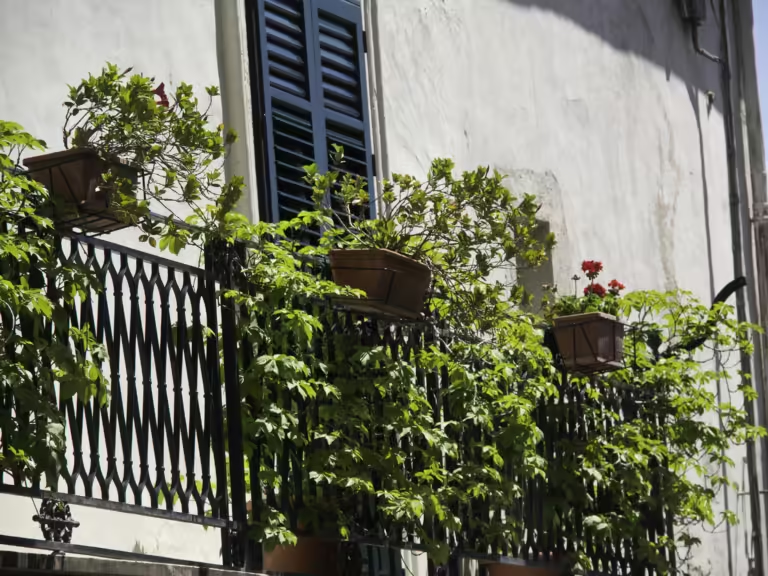15 Low Maintenance Full Sun Plants You’ll Love
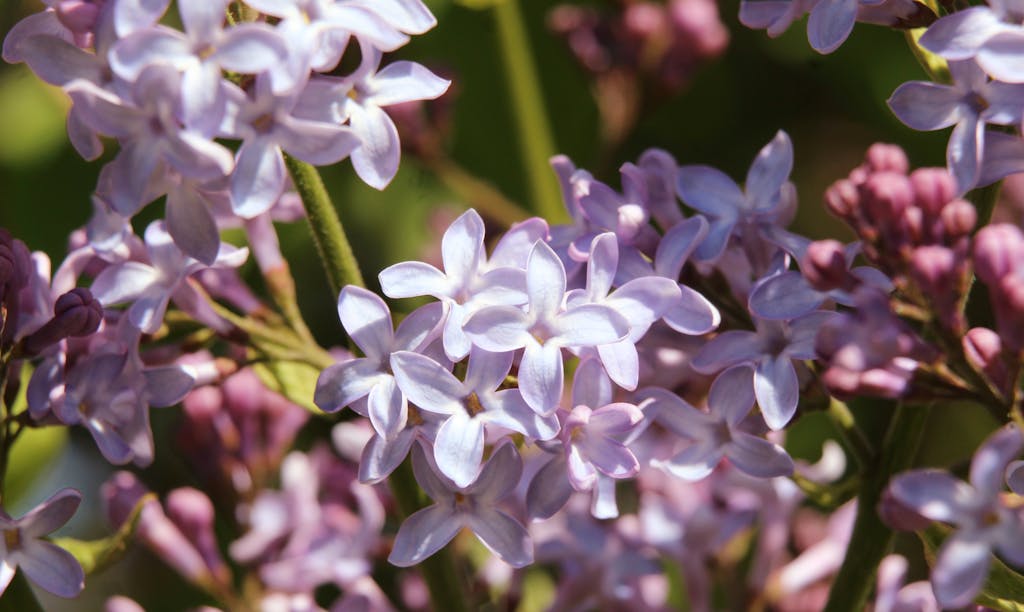
15 Low-Maintenance Full Sun Plants You’ll Love – Sun-hardy, easygoing beauties that thrive without shade, fuss, or daily care. Garden life, simplified.
If you’re seeking vibrant plants that flourish under the sun with minimal care, this guide is for you. These selections are perfect for gardeners who want a beautiful garden, balcony, or window full of blooms without any fuss.
This list mainly focuses on perennials that come back year after year without replanting and with minimal care. If you’re dreaming of a vibrant, fuss-free garden that basks in sunlight all day long, this list is for you.
Related Reads:
- What are Grow Lights for Indoor Plants in 2025?
- 10 Hard To Kill Indoor Plants For Busy People
- Which is the Best Mattress for Your Bedroom? 2025
- Which Bed is Best for Your Bedroom? Complete Guide
- False Ceiling Designs For Bedroom
- 37 Small Space Saving Tips You Should Know
- Finding The Best Curtain Type for Your Living Room
- Best Buying Guide on Big Carpets
15 Low-Maintenance Full Sun Plants You’ll Love are:
1. Russian Sage (Perovskia atriplicifolia)
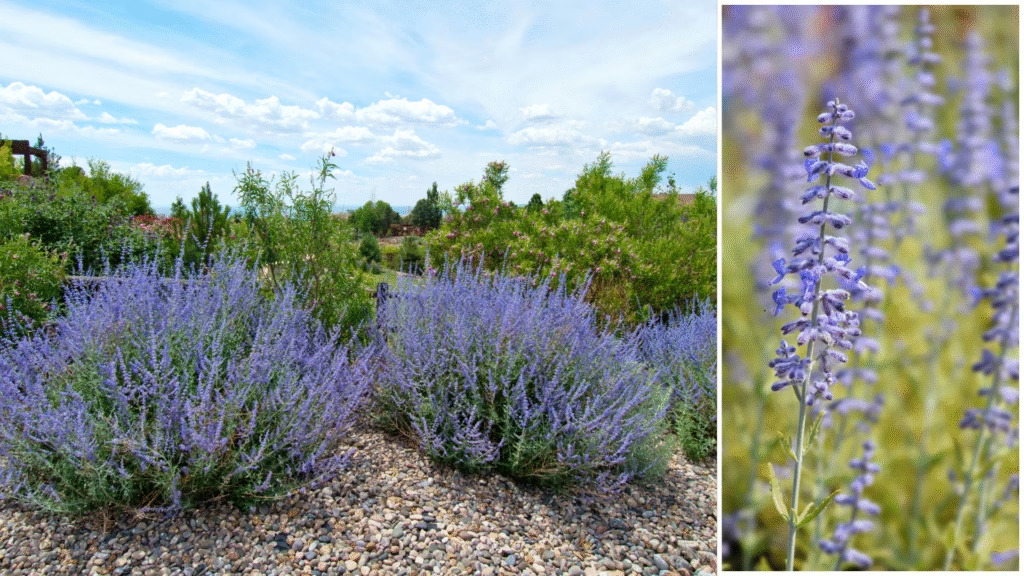
With its silvery-like foliage and Lavender-blue flowers, Russian Sage is a standout and an eye-catcher. It is a perennial plant, and it not only looks great, but it also has many medicinal benefits.
Most people often confuse it with lavender at first sight, and some wonder if it’s better than lavender. The thing is, they are not the same, but can be a stand-in for each other. However, lavender flowers and leaves have a more pronounced sweet scent and a variety of medicinal, herbal, and culinary uses.
People say that Russian sage has a scent like a mix of sage and lavender, whereas Lavender has a floral scent with an herbal undertone.
Zone: Russian sage is a hardy plant in the USDA and will be found in hardiness zones from 4 through 9. They will, however, require some cold climate protection in colder regions of zone 4.
Maintenance – Care Guide
Sunlight: Russian sage needs full sun to thrive. It will be at its best under the bright rays of the sun. A little shade won’t harm it, but it won’t perform its best as the stems will stretch for sunlight. It’s a hardy plant, loves the sun and heat, and is drought-tolerant. It is deer-resistant (for those who have this problem).
Choose a location with hot, intense sun, and even spaces between sidewalks, or streets will work for it, or a strip along your driveway.
Soil: It prefers well-drained soil, sandy or loamy soil.
Watering: Drought-tolerant once planted; water sparingly.
Fertilization: Generally doesn’t require fertilization.
Pruning: Cut back old stems in early spring to encourage new growth.
Propagation: Can be propagated by division and stem cuttings.
Bloom time: Early summer to fall
2. Coneflower (Echinacea purpurea)
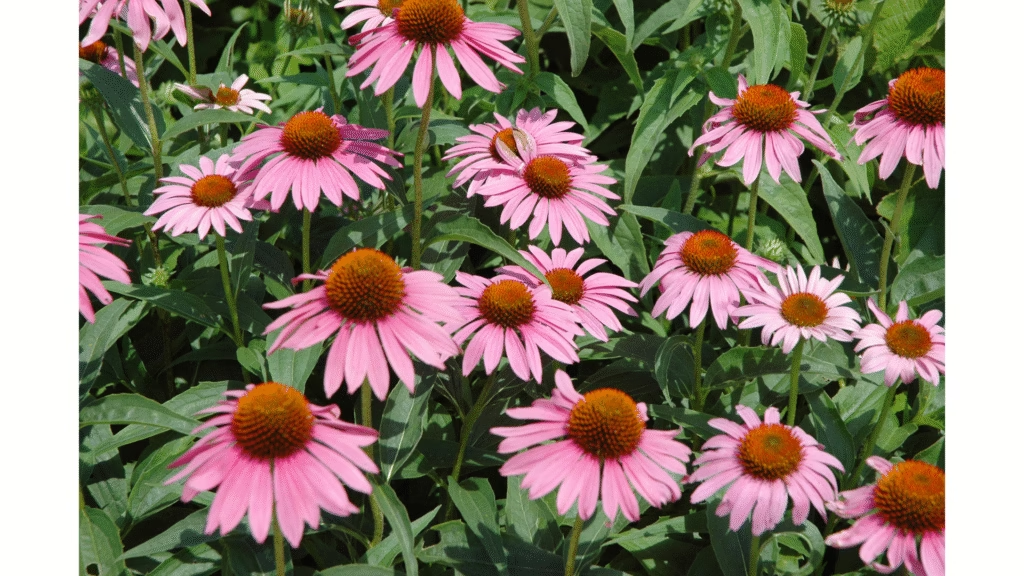
Echinacea, also known as the purple coneflower, is are popular perennial. They’re heat and drought-resistant, easy to grow, and they bloom for months. Coneflowers bloom in various shades of pink, orange, yellow, red, and chartreuse. You’ll also find them in different ranges of flower forms.
Zones: They thrive in USDA hardiness zones. They’re various species range from Zones 4 through 9.
Maintenance – Care Guide
Sunlight: Requires full sun
Soil: Coneflower is adaptable to various soils, but prefers well-drained soil conditions.
Watering: Water it regularly during the first growing season. It is drought-tolerant thereafter. But don’t forget about it entirely.
Fertilization: Minimal – over fertilization can lead to leggy growth.
Pruning: Remove the dead flower heads to prolong blooming season.
Propagation: Propagation can be done by seeds or division (plant a bunch separately, like you would with peace lilies).
3. Black-Eyed Susan (Rudbeckia hirta)
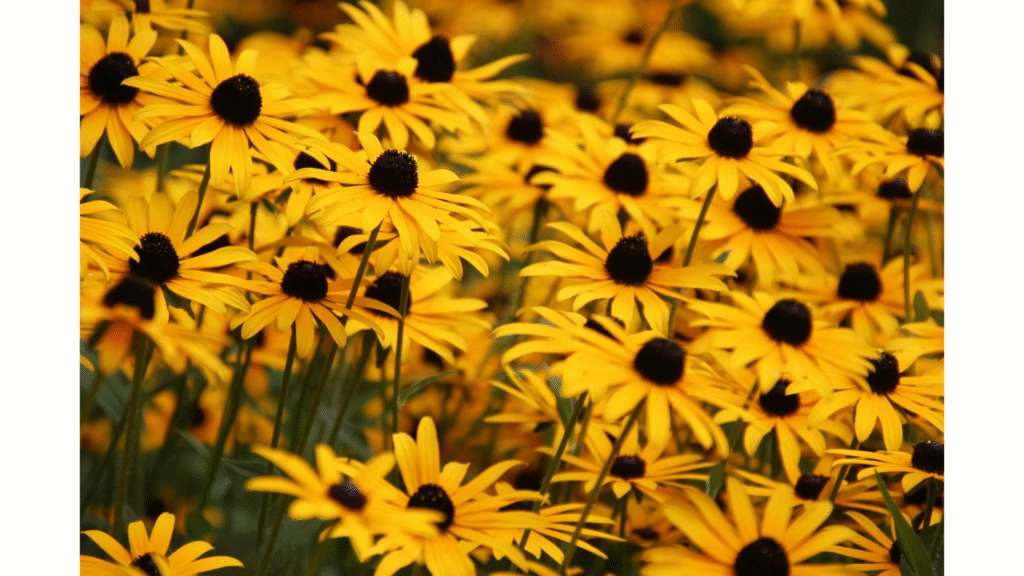
Black-eyed Susans – A member of the aster family – are beloved by pollinators, and they generally bloom from June and August. It is a hardy plant, loves the sun and will forgive neglect.
Zone: Black-eyed Susans, specifically Rudbeckia hirta and other Rudbeckia species, are generally hardy in zones 3 to 9.
Maintenance – Care Guide
Sunlight: Wants full sun but can tolerate partial shade.
Soil: It grows best in moist, well-drained soil. Using a terracotta or clay pot for it would be a good option.
Watering: Requires regular watering when planted, and becomes drought-tolerant once matured.
Fertilization: Black-eyed Susans don’t typically require fertilization.
Pruning: Remove the dead flower heads to prolong the blooming season.
Propagation: It can be propagated by seeding or division.
4. Lavender (Lavandula spp.)
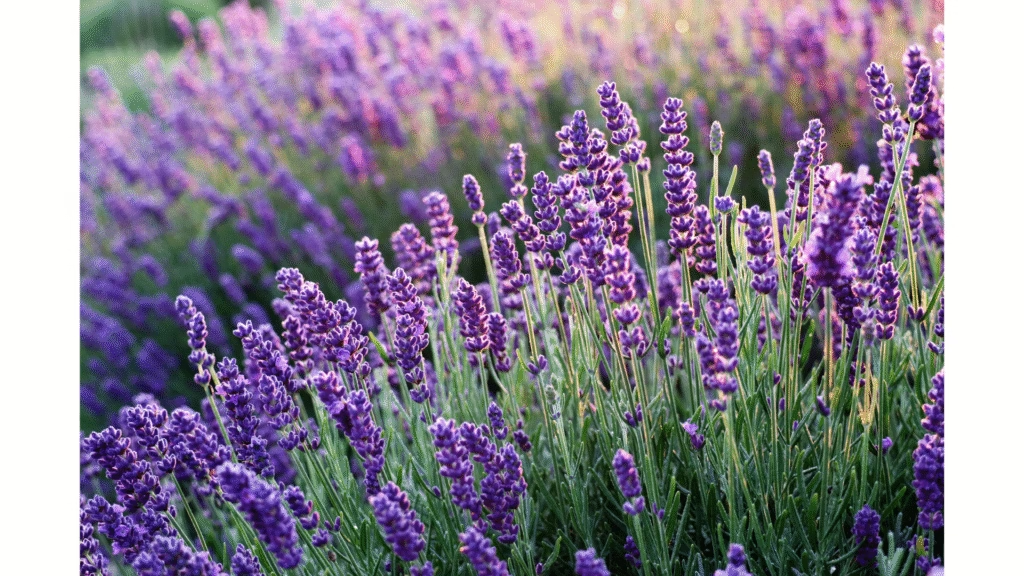
Lavandula (popularly known as Lavender) is a well-known and well-loved perennial flowering plant. It’s famous for its rustic, elegant, and soothing purple flowers, its variety of medicinal and herbal uses, and its sweet floral aroma. Every part of the lavender plant is useful, they’re even desired in their dried form as sachets, potpourri, or as home decor in vases.
Lavender makes a stunning addition to borders and perennial garden areas. They bloom from early summer to fall. They come in a variety of flower forms.
Zone: Lavender plants typically thrive in USDA hardiness zones 5-10.
Maintenance – Care Guide
Sunlight: Needs full sun (at least 6 hours daily).
Soil: Requires well-drained, slightly alkaline soil.
Watering: Water young plants regularly. Mature lavender plants are drought-tolerant.
Fertilization: Avoid over-fertilization. Excessive nutrients can reduce fragrance.
Pruning: Prune annually to maintain shape and encourage new growth.
Propagation: Best propagated through cuttings.
5. Daylily (Hemerocallis spp.)
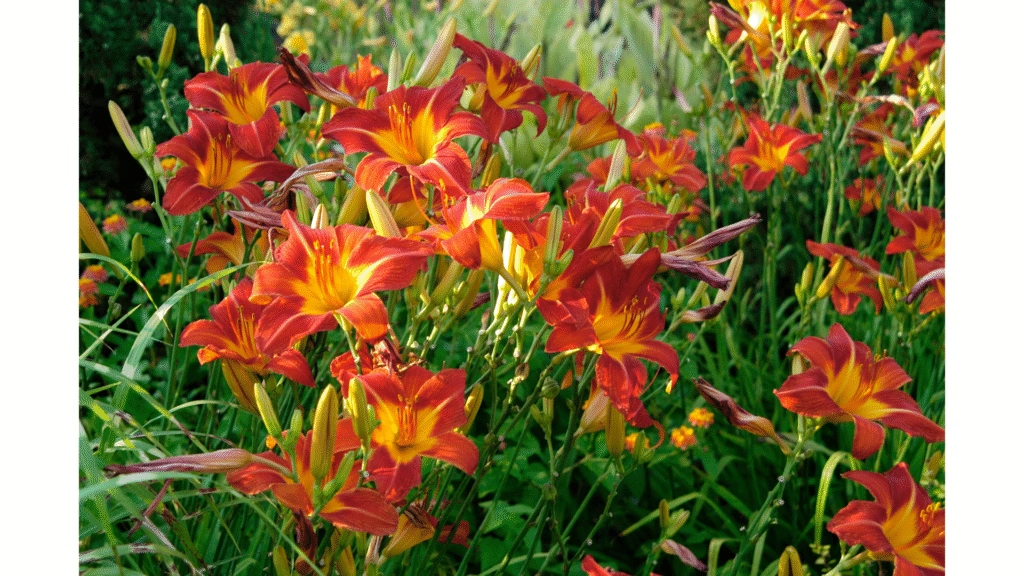
The daylily is an amazing, low-maintenance, full sun-loving flowering perennial plant. It’s a pest-free, drought-tolerant, hardy plant. Plus, they bloom in abundance, though individual blooms only last a single day, and the best part is that it has a vast variety to choose from.
Unlike lilies that grow from bulbs, daylilies grow from fleshy roots.
Zone: Daylilies thrive in zones 4 through 9.
Maintenance – Care Guide
Sunlight: Daylily Full sun to partial shade.
Soil: Prefers rich, well-drained soil.
Watering: Water deeply once a week. Water more during dry spells (prolonged periods of dry weather).
Fertilization: Apply a balanced fertilizer in early spring.
Pruning: Remove spent flowers to encourage reblooming.
Propagation: Divide clumps every few years to maintain vigor.
6. Sedum (Sedum spp.)
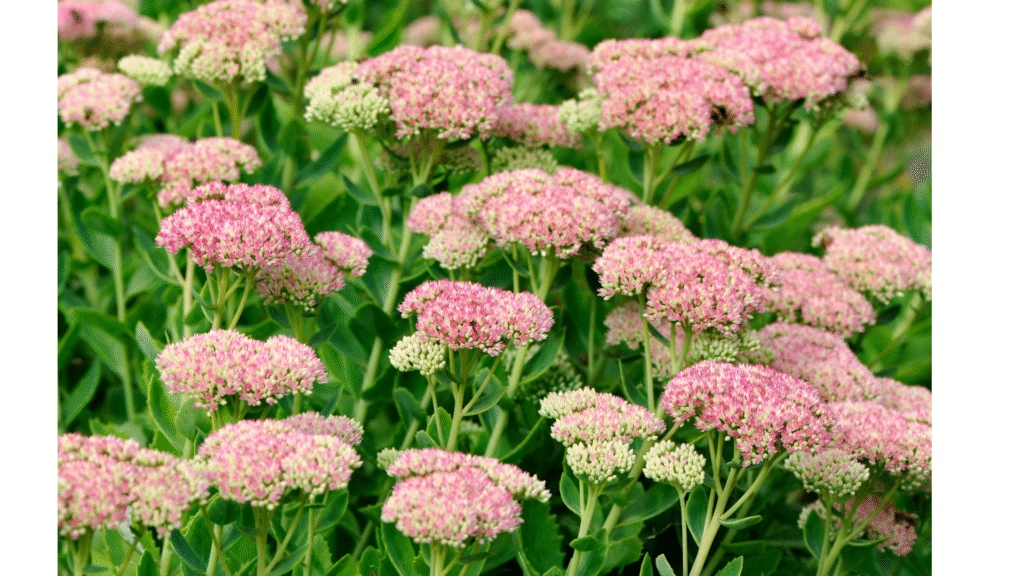
Sedums, or stonecrops, are succulent perennials with fleshy leaves and clusters of star-shaped flowers. Blooming from late summer to fall, they are drought-tolerant and thrive in full sun. Sedums are excellent for rock gardens and borders.
Zone: Hardy in USDA zones 3 to 10
Maintenance – Care Guide
Sunlight: full sun is ideal.
Soil: Thrives in well-drained, sandy or gravelly soil.
Watering: Sedum are drought-tolerant so water sparingly.
Fertilization: Sedum rarely needs fertilization. Over-fertilization can cause floppy growth.
Pruning: requires minimal pruning. Remove the dead stems in spring season.
Propagation: You can easily propagate them by stem or leaf cuttings.
Related Reads:
- Which is the Best Mattress for Your Bedroom? 2025
- Which Bed is Best for Your Bedroom? Complete Guide
- False Ceiling Designs For Bedroom
- 37 Small Space Saving Tips You Should Know
- Finding The Best Curtain Type for Your Living Room
- Best Buying Guide on Big Carpets
- 10 Hard To Kill Indoor Plants For Busy People
7. Coreopsis (Coreopsis spp.)
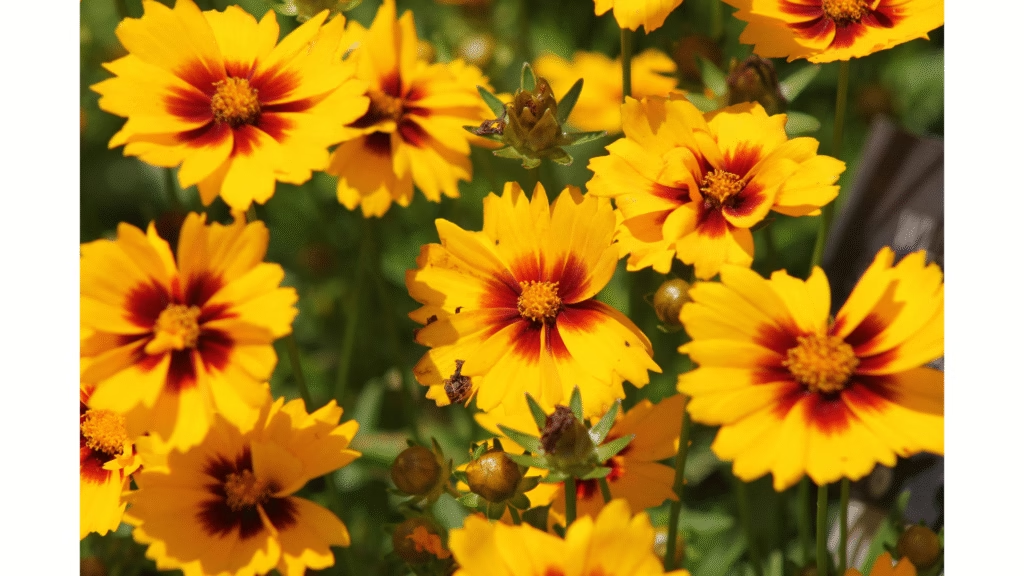
Coreopsis, commonly known as tickseed, offers bright, daisy-like flowers in shades of yellow, pink, and red. Blooming from early summer to fall, they prefer full sun and well-drained soils. Coreopsis attracts butterflies and is excellent for mass plantings.
Zone: Hardy in USDA zones 4 to 10
Maintenance – Care Guide
Sunlight: Coreopsis requires full sun.
Soil: They prefer well-drained soil. They can also tolerate poor soils.
Watering: Requires moderate watering. They are drought-tolerant once established.
Fertilization: Use light fertilization. Light feeding in spring can promote blooms.
Pruning: Remove the deadheads to extend blooming periods.
Propagation: Propagate by division or seeds.
8. Blanket Flower (Gaillardia spp.)

Blanket Flowers are vibrant perennials with red, orange, and yellow blooms resembling sunbursts. Blooming from early summer to fall, they thrive in full sun and well-drained soils. They are drought-tolerant and attract pollinators.
Zone: Hardy in USDA zones 3 to 9
Maintenance – Care Guide
Sunlight: Blanket flowers thrive in full sun.
Soil: Prefers well-drained and sandy soil.
Watering: They are drought tolerant so avoid overwatering.
Fertilization: They require minimal fertilization. Too much fertilizer can reduce blooming.
Pruning: Remove the deadheads of flowers to encourage continuous flowering.
Propagation: You can propagate them from seeds or divide clumps.
9. Yarrow (Achillea millefolium)
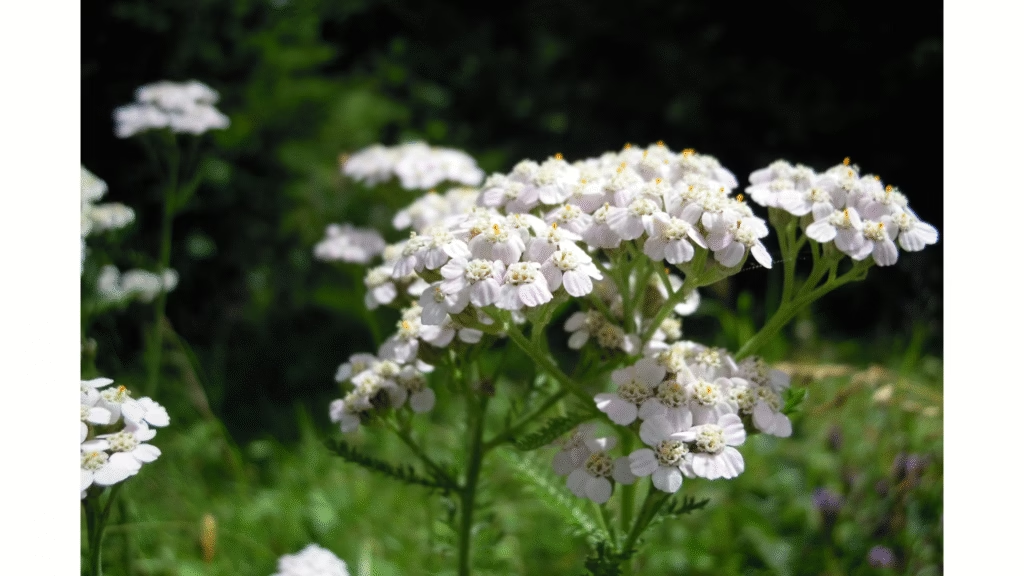
Yarrow is a hardy perennial with feathery foliage and flat-topped clusters of tiny flowers in colors like white, yellow, and pink. Blooming from late spring to early fall, it thrives in full sun and well-drained soils. Yarrow is drought-tolerant and attracts beneficial insects.
Zone: Hardy in USDA zones 3 to 9
Maintenance – Care Guide
Sunlight: Yarrow wants full sun. Full sun is the best for it.
Soil: It can tolerate different ranges of soils, but prefers well-drained conditions.
Watering: Prefers less watering and is drought-tolerant.
Fertilization: Do fertilization rarely.
Pruning: Removed the head flowers to prolong blooming, and cut back in late fall, meaning the parts of the plants that have died or dried up but not fully.
Propagation: Propagate by division or cuttings.
10. Catmint (Nepeta spp.)
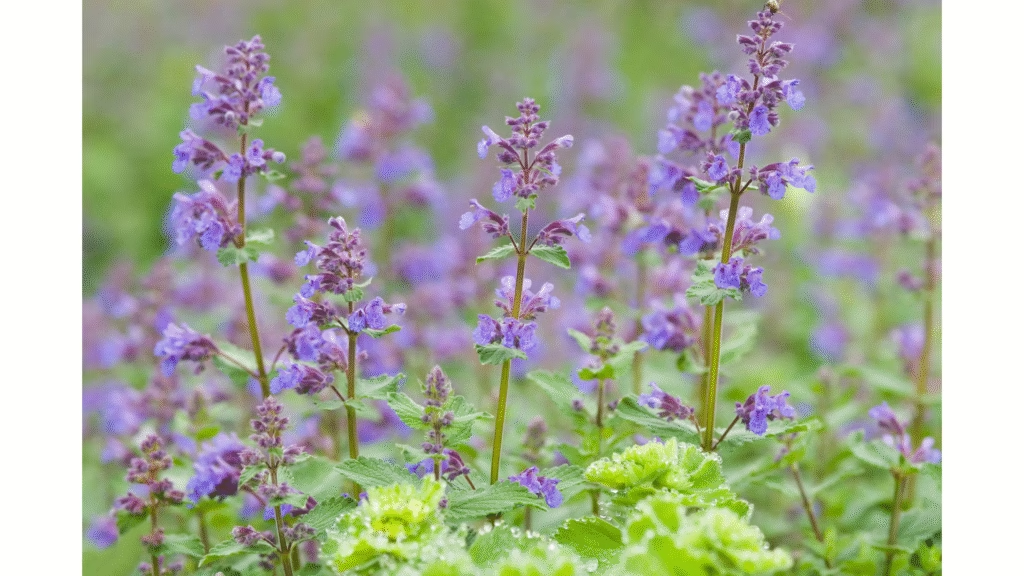
Catmint is a perennial herb with aromatic gray-green foliage and spikes of lavender-blue flowers. Blooming from early summer and often reblooming, it thrives in full sun to partial shade. Catmint is drought-tolerant and attracts pollinators.
Zone: Hardy in USDA zones 4 to 8
Maintenance – Care Guide
Sunlight: Prefers full sun but can tolerate partial shade
Soil: Using well-drained soil is essential.
Watering: Drought-tolerant as it matures.
Fertilization: Requires low fertilization. Over-fertilization will lead to excessive growth.
Pruning: Trim after the first bloom to encourage reblooming.
Propagation: Propagate by division or cutting.
11. Salvia (Salvia spp.)
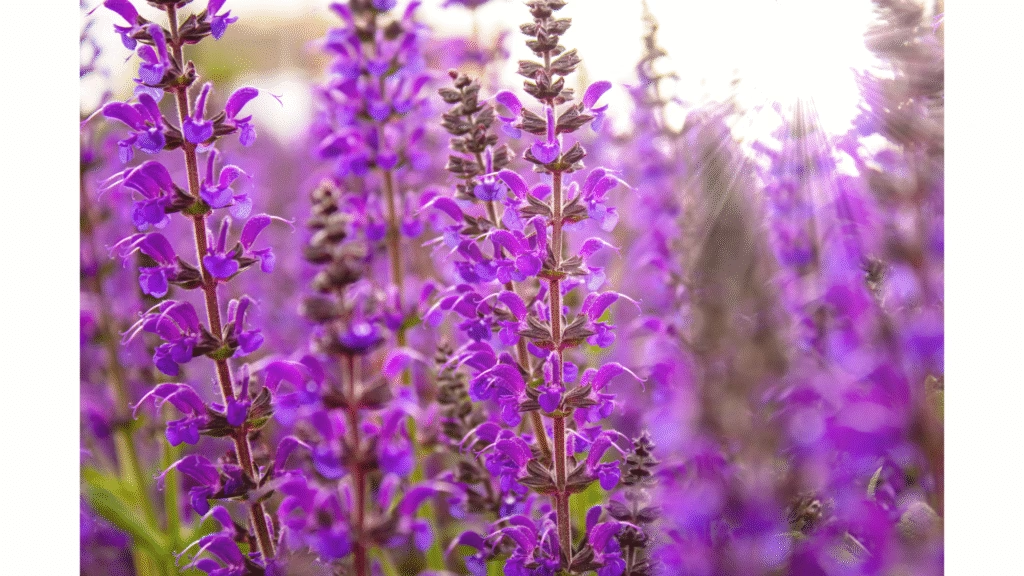
Salvias are a diverse group of perennials known for their vibrant flower spikes in colors like blue, purple, red, and white. Blooming from late spring to fall, they prefer full sun and well-drained soils. Salvias attract hummingbirds and butterflies.
Zone: Hardy in USDA zones 4 to 10
Maintenance – Care Guide
Sunlight: Requires full sun.
Soil: Salvia requires well-drained soil is curial.
Watering: Moderate watering. Allow soil to dry between waterings.
Fertilization: Light feeding in spring promotes growth.
Pruning: Remove the deadhead spent flowers to encourage more blooms.
Propagation: Propagate by cuttings or seeds.
12. Bee Balm (Mondarda didyma)
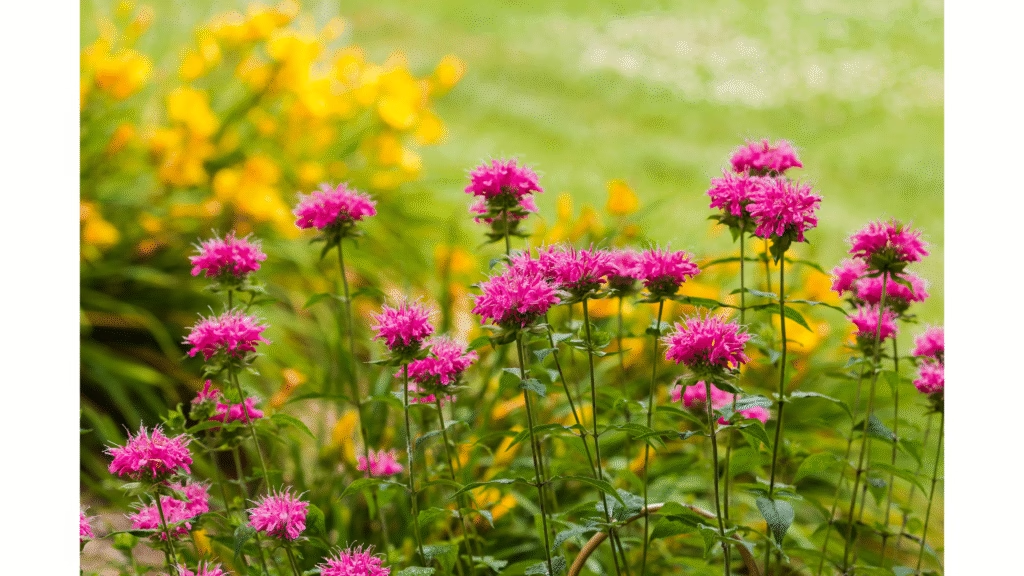
Bee Balm is a perennial with aromatic foliage and tubular flowers in shades of red, pink, and purple. Blooming from mid to late summer, it thrives in full sun to partial shade. Bee balm attracts pollinators like bees, butterflies, and hummingbirds.
Zone: Hardy in USDA zones 4 to 9
Maintenance – Care Guide
Sunlight: Bee balm requires full sun to partial shade.
Soil: Keep the soil consistently moist.
Watering: Apply compost or balanced fertilizer in spring.
Fertilization: Apply compost or balanced fertilizer in spring.
Pruning: Deadhead to prolong blooming; cut back in fall.
Propagation: Divide clumps every few years.
13. Butterfly Weed (Asclepias tuberosa)
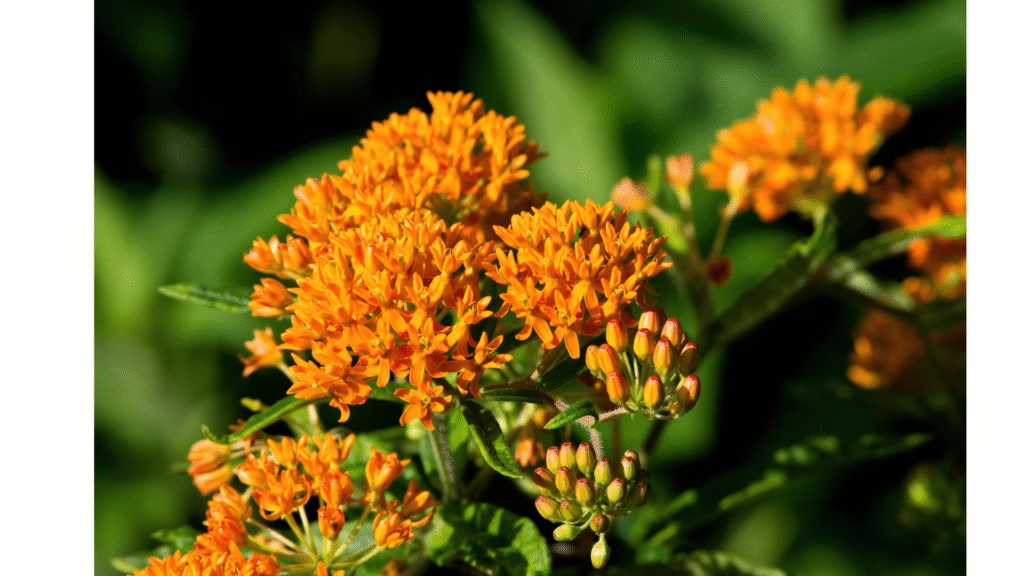
Butterfly Weed is a native perennial known for its bright orange to yellow flower clusters. Blooming from late spring to late summer, it thrives in full sun and well-drained soils. It’s a vital host plant for monarch butterflies.
Zone: Hardy in USDA zones 3 to 9
Maintenance – Care Guide
Sunlight: Butterfly weed needs full sun.
Soil: It prefers well-drained, sandy soil.
Watering: It is drought-tolerant, so water sparingly.
Fertilization: Generally not required.
Pruning: Cut back butterfly-weed in late fall or early spring.
Propagation: Grow them from seeds, and avoid disturbing roots.
14. Ornamental Grasses (Various Species)
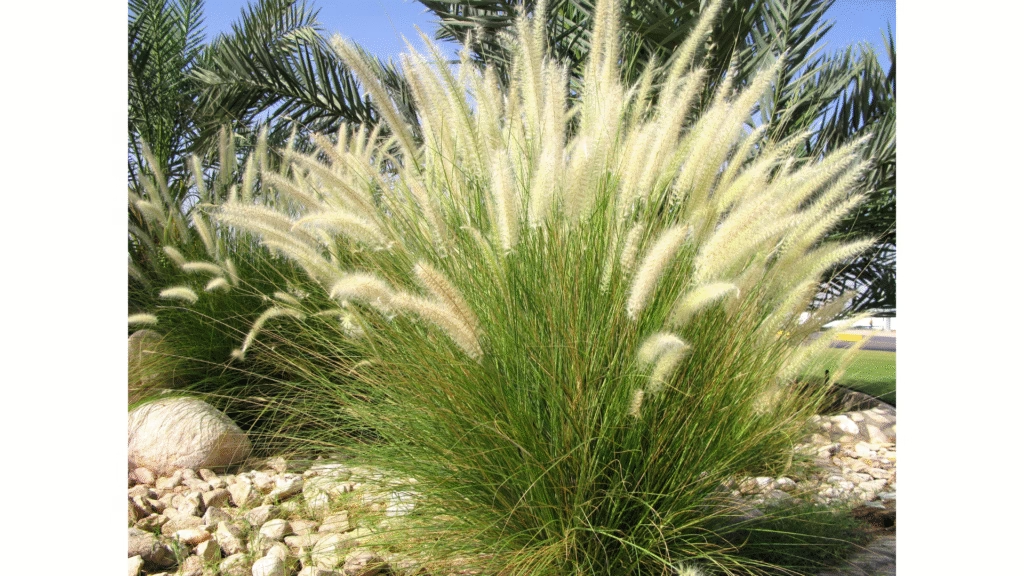
These breezy beauties bring movement, texture, and a wild elegance to any full-sun garden. Ornamental grasses encompass a variety of species offering texture, movement, and seasonal interest.
Blooming times vary, with some producing plumes in summer and others in fall. Hardiness zones range widely, so selection should be based on specific species and local climate conditions
Maintenance – Care Guide
Sunlight: Ornamental grasses – most varieties – prefer full sun; some tolerate partial shade.
Soil: They’re adaptable, and prefer well-drained soil is ideal.
Watering: Requires minimal watering or low watering once established.
Fertilization: Skip the heavy feeding, as too much fertilizer makes them floppy and leggy.
Pruning: Cut back to a few inches above the ground in late winter or early spring before new growth starts. It helps them regrow beautifully.
Propagation: Divide clumps every 3-4 years if they get too big or to share with friends.
15. Zinnia (Zinnia elegans)
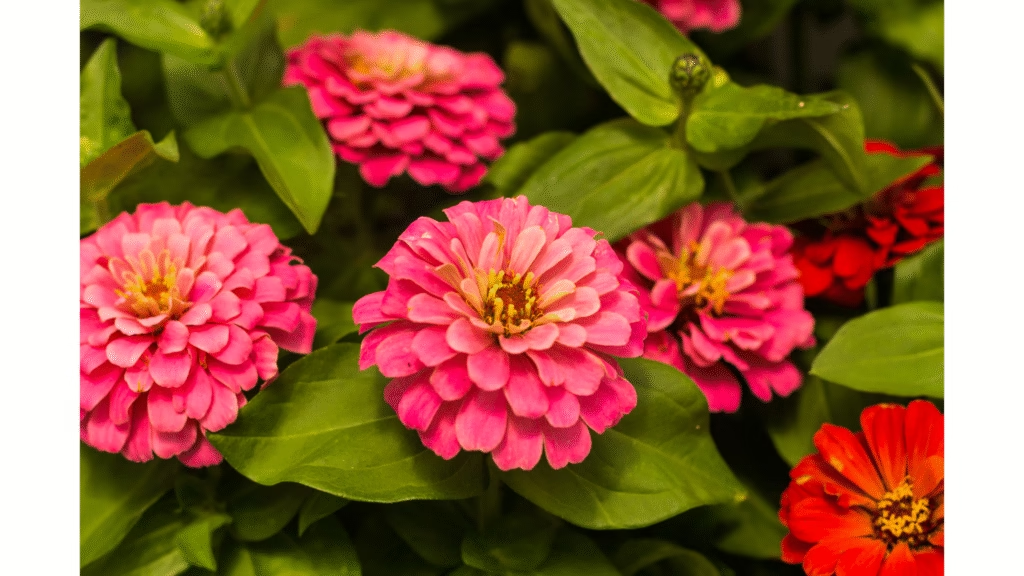
Zinnias are annuals known for their bright, daisy-like flowers in a spectrum of colors. Blooming from early summer until frost, they thrive in full sun and well-drained soils. While not perennials, they are often included in gardens for their long-lasting blooms and ease of care.
Maintenance – Care Guide
Sunlight: full sun all the way. These sun-lovers reward you with nonstop color.
Soil: Loamy, well-drained soil is the best. They’ll sulk in soggy beds.
Watering: Water at the base to avoid powdery mildew. Let the topsoil dry between waterings.
Fertilization: Fertilize in a light amount once or twice during the growing season for better blooms.
Pruning: Regular deadheading keeps blooms blooming.
Propagation: Super easy from seeds – just scatter and watch them grow.
I could have added more to this list. I could have added flowers like marigold, or plants like aloe vera, as they are excellent full-sun, low-maintenance plants, and they definitely deserve a place on this list. However, marigolds are annuals in most climates (especially in temperate zones), and aloe vera is often categorized as a more succulent and medicinal plant than flowering or ornamental perennials used in full-sun landscapes.
Which Country has the Highest Demand for Perennials?
Perennial plants, especially those that are drought-tolerant and thrive in full sun, are highly sought after in several countries due to their adaptability and low maintenance. Countries with significant demand include:
United States: With diverse climates, there’s a high demand for perennials suitable for various zones.
United Kingdom: Gardeners often seek hardy perennials that can withstand varying weather conditions.
Australia: The preference leans towards drought-resistant perennials due to arid regions.
Germany: A strong gardening culture drives the demand for a variety of perennials.
India: Urban gardening and landscaping trends are increasing the demand for sun-loving perennials.
Top Sellers of Perennial Plants in these Countries:
India
- Urvann: Offers a wide range of perennial plants with free next-day delivery in select cities.
- Nurserylive: Features an extensive collection of over 1,000 perennial plants, catering to various gardening needs.
- Alan’s Garden: Specializes in exotic and rare plants, providing personalized service and nationwide shipping.
- Mahindra Nursery: Known for bulk orders and a vast selection of plants suitable for different climates.
United States
- American Meadows: Offers a diverse selection of perennial plants, seeds, and gardening tools.
- Great Garden Plants: Provides a variety of perennials, including native and ornamental species.
- Proven Winners Direct: Known for high-quality plants and innovative gardening solutions.
- Gardening Express: A UK-based company with a significant presence in the US market, offering a wide range of plants.
United Kingdom
- Gardening Express: One of the UK’s leading online plant retailers, offering a vast selection of perennials.
- Jackson & Perkins: Provides a variety of perennials, roses, and gardening accessories.
Australia
- Garden Express: Australia’s leading online nursery, offering a wide range of perennials suitable for various climates.
- The Plant Hub: Specializes in drought-tolerant

